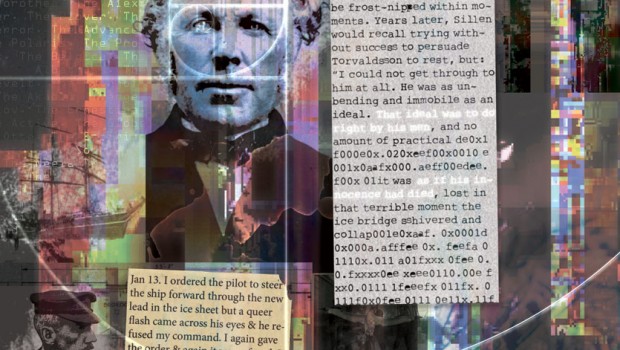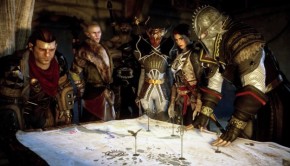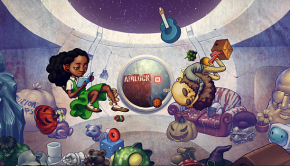Notes From Indiecade: Ice-Bound
The hardest part of talking about Ice-Bound is knowing where to start. After my friend and I saw it, we spent a while walking around, trying to wrap our heads around its mile-high concept, and starting a lot of sentences with “So…” It’s so ambitious and out-there that any one of the bizarre concepts in the mix could serve as a good entry point. Do you open with the “novel remixing” gameplay, where you’re reconstructing a lost classic novel? Or is the AI upload of its author who helps/interferes with the reconstruction a better attention-getter? Maybe the 80-page companion booklet used as an AR supplement to the game? Or the stuff about the secret Antarctic base?
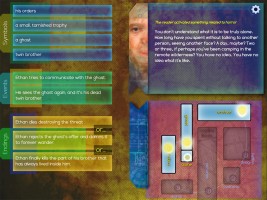 It might be best to just let Aaron Reed and Jacob Garbe, the game’s developers, give their own elevator pitch. “There’s always something lost in summary, but I’d say that Ice-Bound is a game where you can work with KRIS, a simulated author, to finish his masterpiece, a novel called Ice-Bound. You do this in a couple ways, but it boils down to activating different aspects of possible stories, and seeing how those aspects trigger events and endings to cascade from them. A bit like Chekhov’s Gun, but with lots of objects. You also work with an actual printed book that contains clues and materials from KRIS’s life, and use augmented reality to reveal secrets and show them to KRIS. In working to finish Ice-Bound, you’re also working to solve the mystery of KRIS’s life. The two are tightly intertwined.”
It might be best to just let Aaron Reed and Jacob Garbe, the game’s developers, give their own elevator pitch. “There’s always something lost in summary, but I’d say that Ice-Bound is a game where you can work with KRIS, a simulated author, to finish his masterpiece, a novel called Ice-Bound. You do this in a couple ways, but it boils down to activating different aspects of possible stories, and seeing how those aspects trigger events and endings to cascade from them. A bit like Chekhov’s Gun, but with lots of objects. You also work with an actual printed book that contains clues and materials from KRIS’s life, and use augmented reality to reveal secrets and show them to KRIS. In working to finish Ice-Bound, you’re also working to solve the mystery of KRIS’s life. The two are tightly intertwined.”
Moment-to-moment, what you do in Ice-Bound is tinker with the scraps of manuscript by fictional author Kristopher Holmquist, released unedited after his death to viral acclaim. You decide which elements of the fragmented narrative to include, and in what order, to form what you hope will be a compelling story. The reconstruction portions play out in your tablet’s landscape orientation, but rotating the tablet to portrait orientation extrapolates the strung-together segments into a full, readable chapter. It’s the kind of a simple, effective user interface that obviously took a lot of care to get right.
“We have iterated quite a few times on the design,” says Garbe. “Actually, we started off for a good part of the initial design meetings with paper prototypes, which proved incredibly useful. Ice-Bound definitely has a lot of layers and modes of interaction, so it was also a top priority to make it intuitive, so that if players want to dig deeper they can, but until then they aren’t overwhelmed by controls they aren’t ready for or wanting to use yet. It did take awhile to hit on the rotation mechanic to deal with showing lots of text. We spent a lot of design meetings trying to figure out how to cram everything into one view, until that particular revelation allowed us to nicely segment out the content.”
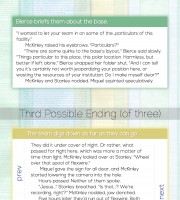 Once you have a story you like, though, you also have to get KRIS, the AI created by publisher Tethys House based on Holmquist’s brain, to sign off on it. If he’s not convinced the manuscript you’ve as assembled it is something he meant to write, he won’t agree to authenticate it. This is where the Ice-Bound Compendium comes in. The physical document is like a scrapbook of articles about Holmquist, his work, his life, and his second life as an AI. By combing through it, you can show KRIS “evidence” that your take is what he planned all along. But KRIS has his own point of view, visible as AR superimpositions through the tablet’s camera, and what you choose to show the AI will affect him as well as your story.
Once you have a story you like, though, you also have to get KRIS, the AI created by publisher Tethys House based on Holmquist’s brain, to sign off on it. If he’s not convinced the manuscript you’ve as assembled it is something he meant to write, he won’t agree to authenticate it. This is where the Ice-Bound Compendium comes in. The physical document is like a scrapbook of articles about Holmquist, his work, his life, and his second life as an AI. By combing through it, you can show KRIS “evidence” that your take is what he planned all along. But KRIS has his own point of view, visible as AR superimpositions through the tablet’s camera, and what you choose to show the AI will affect him as well as your story.
The requirement of the Ice-Bound Compendium to play the game is a bold move for a downloadable title, and is part of the reason the game is, as of this writing, being crowdfunded. “The Kickstarter still has about two weeks left, and we’re working on setting up a way to take orders as soon as it’s over. The game is actually also for PCs with webcams, so the way we’re going to go about it is offering the digital part of the game for free through download or the App Store, and then selling the books through a distributor or off the official website. That way you can get a taste for Ice-Bound as a sort of demo, before the book interactions become necessary to continue the game.”
In those early stages, a host of possibilities are available, but both KRIS and the narrative will be shaped and nudged into definite directions as you go. That sort of cascading decision-making could have potentially resulted in unmanageable script requirements, but the team was careful to design around having to write an expontential amount of content for the game. “We go into it more in our developer blog, but essentially we build the possibility space of the stories from flexible story fragments. These fragments can mold themselves or change context, such that they can be re-used in different combinations sensibly. That’s why we call Ice-Bound a ‘combinatorial narrative.’ What that means for us, fortunately, is that we don’t have to explicitly write all the stories that can be made…rather, we author the material in the possibility space with an eye towards keeping the combinations sensible and storied. It’s definitely a different form of authoring than a branching structure familiar to many people! From the very beginning we’ve been careful to implement the game such that the amount of writing we have to do doesn’t get out of hand. We’re hoping to strike a good balance between high quality hand-authored text, that is also flexible and capable of being mixed to make more emergent narrative combinations.”
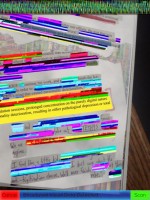 All of that work is to ensure that whatever the outcome of the story, both the one inside the game and the one the game is telling, you own that result–it’s something you specifically made. “We both strongly feel that every story players can make should be equally valid. If you make a game where you have one good ending and everything else is sub-optimal, you’re just making a linear narrative with extra dressing on the side. We’re all about making the material in Ice-Bound equally important, so that people really feel that their story is just as valid a creation as any other.
All of that work is to ensure that whatever the outcome of the story, both the one inside the game and the one the game is telling, you own that result–it’s something you specifically made. “We both strongly feel that every story players can make should be equally valid. If you make a game where you have one good ending and everything else is sub-optimal, you’re just making a linear narrative with extra dressing on the side. We’re all about making the material in Ice-Bound equally important, so that people really feel that their story is just as valid a creation as any other.
“Ice-Bound has the ability to create a staggering amount of different stories, and we’ve structured the game around exploring those possibilities as you move through it. I think technically it’s impossible for someone to see all the content. The tricky thing is that in addition to choosing the combination you prefer most from the set of options on each level, the system remembers and responds to your choices. So if you make stories themed around horror early on, you’re more likely to get options that are more centered around that later in the story. And Ice-Bound currently has 35 themes, so there’s a lot of re-playability. But we’re hoping also that it’s rich enough that even going through the experience once, players are able to feel like they’ve explored and created something they can call their own.”

